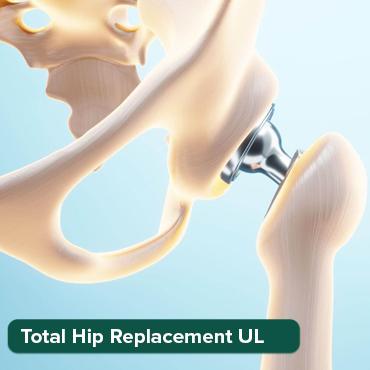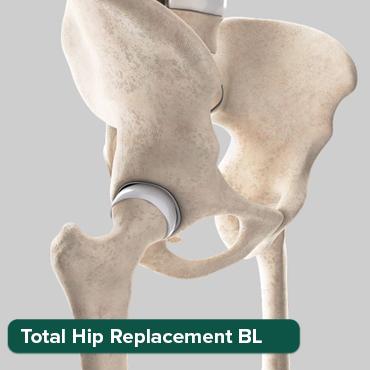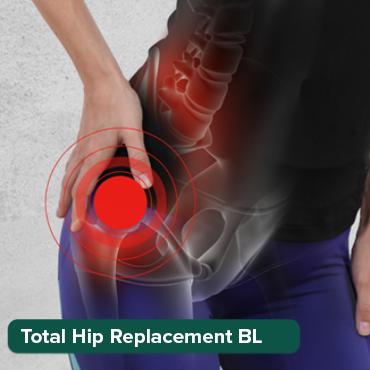
Exercise Plans After Joint Replacement Recommended by Healthtrip
01 Aug, 2025
 Healthtrip
Healthtrip- Benefits of Exercise After Joint Replacement
- Where to Start Your Exercise Journey: Recommended Facilities
- When Can You Start Exercising After Joint Replacement?
- Who Should Be Involved in Your Post-Surgery Exercise Plan?
- How to Create a Gentle and Effective Exercise Routine
- Examples of Recommended Exercises
- Precautions and Potential Challenges
- Conclusion
Understanding the Importance of Exercise After Joint Replacement
Post-operative exercise is not just about physical recovery; it's about reclaiming your life. After undergoing a joint replacement at a facility like Memorial ?i?li Hospital, your body needs to rebuild strength and flexibility around the new joint. Neglecting exercise can lead to stiffness, muscle weakness, and a prolonged recovery period, potentially hindering the benefits of the surgery. A carefully designed exercise plan, recommended and monitored by physical therapists, helps improve circulation, reduce swelling, and prevent blood clots. Moreover, it promotes better joint function and range of motion, allowing you to perform daily activities with ease and confidence. Think of it as investing in the long-term health and functionality of your new joint. Embracing an active recovery can also boost your mental well-being, reducing stress and improving your overall outlook. Finding the right specialists for your journey can be facilitated by Healthtrip, connecting you with world-class healthcare options around the globe! With the support of experienced professionals, you can conquer the challenges of recovery and return to a fulfilling, active lifestyle.
Transform Your Beauty, Boost Your Confidence
Find the right cosmetic procedure for your needs.

We specialize in a wide range of cosmetic procedures

Essential Exercises for Hip Replacement Recovery
Recovering from hip replacement surgery requires a targeted approach to strengthen the surrounding muscles and restore mobility. Simple exercises, like ankle pumps, quad sets, and gluteal squeezes, can be started shortly after surgery to improve circulation and activate key muscle groups. As you progress, your physical therapist, potentially found through Healthtrip options like Fortis Memorial Research Institute, Gurgaon, will introduce exercises like hip abduction, adduction, and gentle range-of-motion movements. These exercises help rebuild strength in the hip abductors, which are crucial for walking and balance. It's vital to follow your therapist's instructions carefully and avoid overexertion. Pain is your body's signal, so pay attention and modify exercises as needed. Remember, consistency is key, even if you can only manage short sessions at first. Gradually increasing the intensity and duration of your exercises will lead to significant improvements in your hip strength, flexibility, and overall function. Working with healthcare professionals helps you regain confidence in your movements and comfortably participate in the activities you enjoy.
Key Exercises Following Knee Replacement
Knee replacement recovery also demands a structured approach to exercise, aiming to restore full range of motion and strength. Immediately post-surgery, exercises like ankle pumps and isometric quadriceps sets help prevent blood clots and begin activating the muscles around the knee. Once you're cleared by your surgeon, perhaps one affiliated with Saudi German Hospital Cairo, Egypt, your physical therapist will guide you through a series of exercises focused on bending and straightening the knee. Heel slides, straight leg raises, and gentle stretches are common starting points. As your strength improves, you'll progress to more challenging exercises like partial squats, step-ups, and eventually, walking and cycling. Maintaining proper alignment during these exercises is essential to protect your new joint. Listen to your body and avoid pushing through sharp pain. With dedication and the guidance of experienced physical therapists, potentially found through Healthtrip, you can regain the strength and mobility needed to return to your favorite activities. Rebuilding that knee strength is the first step towards a life free of pain!
Shoulder Replacement: Effective Exercise Strategies
Recovering from shoulder replacement surgery involves a gradual rehabilitation process focused on restoring range of motion, strength, and stability. Initially, your physical therapist at an institution like Vejthani Hospital may guide you through gentle pendulum exercises and passive range-of-motion movements, where someone else assists in moving your arm. As healing progresses, you'll gradually introduce active-assisted exercises, using your own muscles to move your arm with some support. Later in your program, you’ll move to independent exercises such as rows, lateral raises and internal/external rotation using resistance bands or light weights. These help rebuild strength in the rotator cuff muscles and improve overall shoulder function. Remember to maintain proper posture and avoid shrugging your shoulders during exercise. Listen closely to your body and avoid any movements that cause sharp or radiating pain. A structured exercise plan, tailored to your individual needs and guided by a knowledgeable physical therapist, will help you regain the strength, flexibility, and control needed to perform everyday tasks and enjoy an active lifestyle. Healthtrip can help you find the right specialist for your needs.
The Importance of Professional Guidance and Personalized Plans
While this guide provides a general overview of post-joint replacement exercises, it's crucial to remember that every individual's recovery journey is unique. A physical therapist can assess your specific needs, limitations, and goals, and design a personalized exercise plan that's safe and effective for you. They can also monitor your progress, make adjustments to your plan as needed, and provide valuable feedback and support. Trying to progress too quickly or performing exercises incorrectly can lead to complications and setbacks. Seeking professional guidance from facilities like NMC Specialty Hospital, Al Nahda, Dubai, ensures you're on the right track and maximizing your chances of a successful recovery. Healthtrip can connect you with qualified healthcare professionals who can provide the individualized care and attention you deserve. Working with a skilled therapist is an investment in your long-term health and well-being.
Benefits of Exercise After Joint Replacement
Undergoing joint replacement surgery is a significant step towards reclaiming your mobility and quality of life. The journey doesn't end in the operating room; in fact, it's just the beginning of an exciting chapter focused on rehabilitation and recovery. One of the cornerstones of a successful recovery is exercise. Engaging in a well-structured exercise program after joint replacement offers a multitude of benefits that extend far beyond simply regaining physical strength. Imagine being able to walk without pain, climb stairs with ease, and participate in activities you once enjoyed with renewed vigor. This is the promise of post-operative exercise.
Most popular procedures in India
Total Hip Replacemen
Upto 80% off
90% Rated
Satisfactory

Total Hip Replacemen
Upto 80% off
90% Rated
Satisfactory

Total Hip Replacemen
Upto 80% off
90% Rated
Satisfactory

ASD Closure
Upto 80% off
90% Rated
Satisfactory

Liver Transplant Sur
Upto 80% off
90% Rated
Satisfactory

The benefits of exercise after joint replacement are wide-ranging and profound. Improved range of motion is paramount; targeted exercises help to gently stretch and mobilize the tissues around the new joint, preventing stiffness and promoting flexibility. Stronger muscles provide essential support and stability to the joint, reducing the risk of future injuries and improving overall function. Pain reduction is another significant advantage. Exercise helps to alleviate discomfort by releasing endorphins, natural pain relievers produced by the body. Improved circulation ensures that the joint receives adequate blood flow, promoting healing and reducing inflammation. Beyond the physical benefits, exercise also boosts your mood and overall well-being. The sense of accomplishment that comes with each milestone achieved, each step taken, and each exercise completed can be incredibly empowering, contributing to a more positive and optimistic outlook on your recovery journey. Remember, at Healthtrip, we want to empower you to live your healthiest life, and exercise after joint replacement is a key piece of that puzzle. We are here to help you facilitate your medical journey, from finding the right surgeon to providing information to make the process easier.
Finally, consistent exercise helps prevent complications like blood clots and pneumonia, which can sometimes occur after surgery. Exercise after joint replacement at hospitals such as Fortis Memorial Research Institute, Gurgaon, India or Saudi German Hospital Cairo, Egypt, if the opportunity arises reduces the likelihood of needing additional medical interventions, which could potentially save you money and time in the long run. Consider exercise as an investment in your long-term health and well-being. It's an opportunity to not only recover from surgery but also to build a stronger, healthier, and more resilient you. With the right guidance and commitment, you can unlock the full potential of your new joint and experience a life free from pain and limitations.
Where to Start Your Exercise Journey: Recommended Facilities
Embarking on your post-joint replacement exercise journey often begins with selecting the right facility to support your rehabilitation. The choice of location can significantly impact your progress and overall experience. Hospitals and rehabilitation centers are often the first port of call after surgery. These facilities offer a comprehensive range of services, including physical therapy, occupational therapy, and pain management, all under the supervision of experienced medical professionals. For instance, hospitals like Fortis Hospital, Noida, or Vejthani Hospital in Bangkok, are equipped with specialized rehabilitation units designed to cater to patients recovering from orthopedic procedures.
Physical therapy clinics represent another excellent option for ongoing rehabilitation. These clinics specialize in musculoskeletal health and offer individualized exercise programs tailored to your specific needs and goals. A qualified physical therapist can assess your condition, identify areas of weakness or limitation, and design a program to address these issues. They provide hands-on guidance, monitor your progress, and adjust the program as needed to ensure optimal results. Many hospitals also run outpatient physical therapy clinics, like Saudi German Hospital Cairo, Egypt, allowing you to benefit from hospital-grade care without being admitted as an inpatient.
For those who prefer a more independent approach, home-based exercise programs can be a viable option, but only with the guidance of a physical therapist or physician. This approach allows you to exercise in the comfort and convenience of your own home, at your own pace. Your therapist will provide you with a detailed exercise plan, along with instructions on proper form and technique. Regular follow-up appointments are essential to monitor your progress and make any necessary adjustments to the program. Remember, regardless of the setting you choose, it's crucial to prioritize safety and adhere to your healthcare provider's recommendations. Starting slowly, gradually increasing the intensity and duration of your workouts, and listening to your body are all essential for a successful recovery. You can easily check out the facilities available at hospitals like Memorial ?i?li Hospital and Cleveland Clinic London, through Healthtrip. Healthtrip provides you with details to help you make informed decisions about your care.
When Can You Start Exercising After Joint Replacement?
The timeline for starting exercise after joint replacement is a common concern for many patients, and rightfully so. It's a delicate balance between wanting to get back on your feet as soon as possible and allowing your body sufficient time to heal. Generally, the rehabilitation process begins very soon after surgery, often within the first 24-48 hours. This initial phase focuses on gentle movements and exercises designed to prevent complications, such as blood clots and pneumonia, and to promote early range of motion. For example, a physical therapist might guide you through simple ankle pumps, quad sets (tightening the thigh muscles), and gentle knee bends while you are still in the hospital.
The specific timing and progression of exercises will vary depending on several factors, including the type of joint replacement you had, your overall health, and your surgeon's recommendations. Your medical team will consider any underlying health conditions you may have, such as diabetes or heart disease, which could affect your healing process. The complexity of your surgery and the stability of your new joint will also play a role in determining when you can begin more strenuous activities. As a general guideline, the first few weeks after surgery focus on pain management, wound care, and restoring basic mobility. As your pain decreases and your strength improves, you'll gradually progress to more challenging exercises. This might involve using assistive devices like walkers or crutches, and gradually increasing the distance you can walk. Remember, patience is key. Don't be discouraged if you don't see immediate results.
Around 6-12 weeks after surgery, you'll typically begin to focus on strengthening exercises and increasing your functional capacity. This might involve activities like cycling, swimming, or light weightlifting. The goal is to gradually return to your pre-surgery activity level, while avoiding activities that put excessive stress on the new joint. Keep in mind that everyone recovers at their own pace. Some people may progress through the rehabilitation stages more quickly than others. It's essential to listen to your body, communicate openly with your healthcare providers, and adjust your exercise program accordingly. At Healthtrip, we understand that undergoing joint replacement surgery can be a daunting experience. Finding the right facility to meet your health needs is important, you can explore options like Yanhee International Hospital or Bangkok Hospital through our platform.
Also Read:
Who Should Be Involved in Your Post-Surgery Exercise Plan?
Recovering from joint replacement surgery isn't a solo mission; it's more like assembling a fantastic team to help you get back on your feet – or, more accurately, back to your active life. Think of it as your personal pit crew in a race to recovery. At the heart of this team is, of course, your orthopedic surgeon. They’re the captain of the ship, guiding the overall recovery process, monitoring your progress, and ensuring that everything is healing correctly. They will provide the initial clearance for when you can start exercising and any specific precautions you need to take based on your individual surgery and health status. Next up, and arguably the most hands-on member of your team, is your physical therapist. These are the movement maestros who will craft a personalized exercise plan, teaching you the correct techniques to rebuild strength and mobility safely. They’ll be your cheerleaders, coaches, and sometimes, the gentle push you need when motivation wanes. Don't underestimate the power of your primary care physician either! Having them in the loop ensures that your post-surgery exercise plan aligns with any other health conditions you might have. They're the bridge between your joint replacement and your overall well-being.
And let's not forget the unsung heroes: your family and friends. Their support can make a world of difference. They can help with practical tasks, provide emotional encouragement, and even join you on walks or exercise sessions. Turning your recovery into a shared activity can make it more enjoyable and sustainable. Healthtrip understands the importance of a holistic approach to recovery. We can connect you with top orthopedic surgeons and physical therapists globally, ensuring you have the best possible team supporting your journey. Whether you're considering surgery at Fortis Memorial Research Institute, Gurgaon or seeking post-operative care closer to home, we're here to help you build your dream team.
Also Read:
How to Create a Gentle and Effective Exercise Routine
Creating a post-joint replacement exercise routine is like baking a cake – you need the right ingredients, the right recipe, and a little patience. You're not going to jump straight into a marathon; instead, you'll start with simple, low-impact exercises that gradually build strength and flexibility. Think of it as waking up your joint from its post-op slumber. Starting slow is key, and by slow, we mean *really* slow. Begin with gentle range-of-motion exercises, like ankle pumps, knee slides, and gentle hip rotations. These movements help to improve circulation, reduce stiffness, and prevent blood clots. Imagine you're coaxing your joint to remember how it used to move. As you progress, you can gradually add strengthening exercises. These might include isometric exercises, where you contract your muscles without moving your joint, or light resistance exercises using bands or weights. The goal is to strengthen the muscles around your joint, providing support and stability. Think about building a strong foundation for your new joint to thrive on. Listening to your body is crucial; pain is a signal that you're pushing too hard. Don't be a hero! Rest when you need to, and don't be afraid to modify exercises to suit your comfort level. Consistency is more important than intensity. Aim for short, frequent exercise sessions rather than long, infrequent ones. Even 10-15 minutes of exercise several times a day can make a big difference. It's like sprinkling water on a plant – regular, small doses are more effective than one big drench. Healthtrip Tip: Consider consulting with a physical therapist who specializes in post-joint replacement rehabilitation. They can create a personalized exercise routine and help you progress safely and effectively. Hospitals like Fortis Hospital, Noida and Saudi German Hospital Cairo, Egypt have excellent rehabilitation programs.
Remember, this is a marathon, not a sprint. Building endurance is the name of the game. As your strength improves, gradually increase the duration and intensity of your exercises. But always listen to your body and avoid pushing yourself too hard, too soon. Think of it as a gentle climb – steady and sustainable. And don’t forget the importance of proper warm-up and cool-down routines! Prepping your muscles and joints before exercise can help prevent injuries, while cooling down afterwards can reduce muscle soreness. It's like stretching before a long car ride – it prevents cramping and keeps you comfortable. You got this!
Examples of Recommended Exercises
Now that we've talked about the importance of a gentle and effective exercise routine, let's dive into some specific examples of exercises that are typically recommended after joint replacement surgery. Remember, always consult with your physical therapist or doctor before starting any new exercise program. These are general guidelines, and your individual needs may vary. Ankle Pumps: This is a great exercise to start with in the early days after surgery. Simply point your toes up towards the ceiling and then down towards the floor. Repeat this movement several times to improve circulation in your legs and feet. It's like giving your legs a gentle wake-up call. Heel Slides: Lying on your back, slowly slide your heel towards your buttocks, bending your knee as far as comfortable. Then, slowly straighten your leg back to the starting position. This exercise helps to improve knee flexion and extension. Think of it as lubricating your knee joint. Quad Sets: Tighten the muscles on the front of your thigh (your quadriceps) while keeping your leg straight. Hold the contraction for a few seconds and then relax. This exercise helps to strengthen your quadriceps muscles, which are essential for knee stability. Picture yourself building a fortress of strength around your knee. Short Arc Quads: Place a rolled-up towel under your knee. Tighten your quadriceps muscles and straighten your knee as much as possible. Hold for a few seconds and then relax. This exercise is similar to quad sets but provides a slightly greater range of motion. It's like stretching your knee's comfort zone. Gluteal Sets: Squeeze your buttocks muscles together and hold for a few seconds. Then, relax. This exercise helps to strengthen your gluteal muscles, which are important for hip stability and balance. Imagine yourself sculpting your glutes into a supportive powerhouse. Standing Hip Abduction: While holding onto a chair or countertop for support, slowly lift one leg out to the side, keeping your leg straight. Hold for a few seconds and then lower your leg back to the starting position. This exercise helps to strengthen the muscles on the outside of your hip. Think of it as strengthening your hip's stabilizers.
As you progress, you can also incorporate low-impact cardiovascular exercises like walking, stationary cycling, or swimming. These activities help to improve your overall fitness and endurance. Walking is a fantastic option, but start with short distances on flat surfaces and gradually increase the distance and intensity as tolerated. Stationary cycling is another great choice because it's low-impact and allows you to control the resistance. Swimming is particularly gentle on your joints because the water provides buoyancy and support. It's like giving your joints a spa day. Remember, the key is to listen to your body and progress gradually. Don't be afraid to modify exercises or take breaks when needed. And most importantly, celebrate your progress along the way! Every step forward is a victory. Healthtrip can help you find the best rehabilitation centers and physical therapists, even connecting you with facilities like Vejthani Hospital or Bangkok Hospital for comprehensive post-operative care.
Also Read:
Precautions and Potential Challenges
Navigating the post-joint replacement recovery journey requires a bit of caution and awareness of potential challenges. It’s not always smooth sailing, but with the right preparation and knowledge, you can steer clear of common pitfalls. One of the biggest precautions is avoiding high-impact activities that can put excessive stress on your new joint. Think jumping, running, or any activity that involves a lot of pounding. These activities can increase the risk of complications and premature wear and tear on your joint. Instead, focus on low-impact activities that are gentle on your joints, like walking, swimming, or cycling. Another important precaution is to avoid twisting or pivoting movements, especially in the early stages of recovery. These movements can put stress on the ligaments and muscles around your joint, increasing the risk of injury. When turning, take small steps and avoid sudden, jerky motions. Proper body mechanics are crucial. Be mindful of your posture and how you move throughout the day. Avoid slouching or hunching over, as this can put unnecessary strain on your joints. Use assistive devices, like canes or walkers, as recommended by your physical therapist, to provide support and stability. Pain management is another key aspect of post-operative care. It’s normal to experience some pain and discomfort after surgery, but it’s important to manage your pain effectively. Follow your doctor’s instructions for pain medication and consider other pain relief strategies, such as ice packs, heat packs, or massage. Don't tough it out; address the pain proactively. Infection is a serious complication that can occur after any surgery, including joint replacement. Be vigilant about wound care and follow your doctor’s instructions carefully. Watch for signs of infection, such as increased redness, swelling, drainage, or fever. If you notice any of these symptoms, contact your doctor immediately. Blood clots are also a potential risk after joint replacement surgery. Your doctor may prescribe blood thinners to help prevent blood clots. Be sure to take your medication as directed and follow your doctor’s instructions for monitoring your blood. Dehydration is another common challenge during recovery. It’s important to drink plenty of fluids to stay hydrated, especially if you’re taking pain medication or experiencing swelling.
Remember, Healthtrip is here to support you every step of the way. We can connect you with world-class medical facilities like LIV Hospital, Istanbul or Quironsalud Hospital Murcia and experienced healthcare professionals who can provide personalized guidance and support throughout your recovery journey. Don't hesitate to reach out to us for assistance.
Conclusion
Embarking on the journey after joint replacement surgery can feel like setting sail into uncharted waters. It's a path filled with potential challenges, but also brimming with the promise of renewed mobility and a better quality of life. As we've explored, a successful recovery hinges on a well-structured exercise plan, a supportive healthcare team, and a proactive approach to your own well-being. From understanding the crucial role of your physical therapist to recognizing the importance of gentle, progressive exercise, you now have a toolkit of knowledge to navigate this journey with confidence. Remember, this isn't a race, but a carefully paced marathon. Listen to your body, celebrate small victories, and don't hesitate to seek guidance when you need it. Whether it’s connecting with top-notch medical facilities like Fortis Escorts Heart Institute or finding the right rehabilitation program, Healthtrip is dedicated to assisting you at every turn. Consider exploring options like the specialized care at Yanhee International Hospital or the comprehensive support systems at Memorial Sisli Hospital, both of which focus on patient-centered recovery. By taking a proactive role in your recovery and leveraging the resources available, you can confidently look forward to a future where your new joint empowers you to live life to the fullest. Here's to a smoother, stronger, and more mobile you!
Wellness Treatments
Give yourself the time to relax
Lowest Prices Guaranteed!

Lowest Prices Guaranteed!







